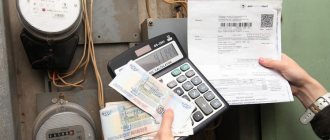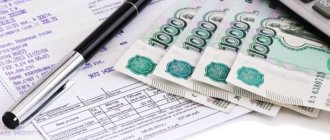Personal accounts: main types
Confusion in personal accounts is common. This is due to ignorance of their features and design methods. Today the following types of personal accounts :
- Employee (used in company personnel records). This l/s contains the following data:
- Information about payroll.
- Data on financial assistance, allowances, bonuses and compensation.
Personal information is used to calculate tax payments. The storage period for documents is 75 years.
- Bank. This personal account contains information about the financial relationship between the credit institution and the account owner. Personal bank accounts are often set up for each type of transaction. For each individual account, a register is allocated and a personal account is issued.
Data in personal information is confidential. The banking institution is responsible for protecting information from outsiders, but if there is a request from the Federal Tax Service, the data is provided without delay.
- Taxpayer. Each person has an individual “tax” personal account, which is maintained in national currency. Such a personal identification number is issued simultaneously with the assignment of a TIN to the Federal Tax Service. Feature - accounting of receipts and payments, based on the characteristics of the budget classification.
- Manager. Budget allocation data is displayed here.
- Shareholders. This l/s reflects data on assets that are in the possession of citizens, individual entrepreneurs or companies.
From the shareholder's personal account you can find out:
- Type and category of exchange instruments.
- Number of securities.
- Registration number.
- Price and data on securities transactions.
- The insured person. This personal account is used to obtain information about an individual and transfer his pension. Each insured person has his own number.
Why do you need an MKD personal account and how to open it
Maintenance of common property is the responsibility of the management company, which is a hired structure. In accordance with current legislation, she must receive specific tasks relating to this MKD.
The building council is created precisely to ensure that this area of public life is as transparent as possible for apartment owners. Unfortunately, such bodies have not been formed in all apartment buildings, and this leads to inconsistency in the actions of residents: demands are sent to the management company for the implementation of which no money was allocated.
To create an effective system for monitoring the receipt and expenditure of financial resources, at the insistence of the house council, the management company can open a separate personal account for the apartment building.
A personal apartment account is needed in order to reflect in it everything that concerns the financial issues of common property, from the cost of replacing a light bulb in the entrance to the cost of current repairs. The Housing Code (Articles 36–39) stipulates ownership rights in the joint asset of apartment buildings, the share of owners and their responsibilities for the maintenance of collective real estate. And one more document - Art. 16 Federal Law No. 189, which clearly defines the procedure for the formation of the territory on which the apartment building is located, and the transfer of rights to it to the owners of the premises of the house.
It follows from this that apartment residents own common property, which includes everything, with the exception of premises for various purposes owned by specific individuals, and the land plot adjacent to the building.
The public property of apartment buildings is maintained at the expense of the owners of both residential and non-residential premises in accordance with established tariffs.
This money is reflected in the personal account of the MKD.
The management company provides a report on the movement of these funds annually.
Previously, money was collected for repairs and maintenance of housing, and then they began to accumulate it in the cash register of the management company, which distributed the available funds for the maintenance of any of the houses on its territory.
How to find out your personal bank account?
To find out your personal bank account , you should use one of the following ways:
- Through your personal online banking account.
- Check the number at the branch of the financial institution.
- Call the hotline and follow the operator's instructions.
A bank personal account may be required to withdraw money, make a transfer, or obtain personal data.
The structure of a personal account number in a bank is twenty digits that differ from the number on a bank card. The latter changes if a new “plastic” is released, but the l/s number remains unchanged.
To whom is the HOA personal account certificate issued?
To use a personal account, a citizen must own housing for one of the following reasons:
- use under a social rental agreement;
- rent from a state or municipal fund;
- obtain state or municipal property for rent;
- be a member of a housing cooperative;
- have the right of ownership;
- accept premises from the developer after the new house is put into operation;
- be a developer (until the housing is put into operation).
The most inconvenient is the third method. In order to find out the number, the user will have to contact the bank branch through which he makes payments. Next, you need to tell the employee the address and get information about the number. However, it will be easier and faster to use your bank’s online service. Personal accounts in housing associations are not bank accounts, unlike settlement accounts; they are necessary for internal identification of subjects of financial transactions carried out by the HOA. We can say that this document is characterized by a certain legal duality, since it contains a list of registered persons, financial information, some technical characteristics, the presence of communication systems and even clauses about citizens who legally retain the right to use the apartment. A personal account number for paying for utilities is an electronic storage of information that contains data on the technical characteristics of the living space, the number of registered persons and the connected communication lines. All utility payments for the apartment are transferred to the housing and communal services settlement center directly to personal accounts. If necessary, a single housing and communal services account number is divided into several people. This is useful if the apartment has several owners. How can I find out the housing and communal services account number at the address, and how can I use it to check my rent debt? Let's figure it out.
How to open a bank personal account?
To open a bank personal account , you should do the following:
- Contact the financial institution of interest.
- Give your passport to the employee of the institution (foreigners will need a second document).
- Select currency.
- Place a sample signature on the special card.
- Sign the contract.
- Put money on the account for storage.
To open a personal bank account , you need to spend no more than 10-15 minutes. In the future, you can use your account - add/withdraw funds or make transfers.
How to open a treasury account: step-by-step instructions
The current procedure for opening and maintaining personal accounts in TOFK is established by the Federal Treasury of Russia. Today, the procedure is regulated in a special order dated October 17, 2016 No. 21n (as amended on December 28, 2017).
To open a CSC for a legal entity, follow the instructions.
Prepare two key documents: an application for opening a personal account and a card of sample signatures. If the DSC is planned to be opened for a separate division of the company, then in addition to the required documents, prepare a petition from the parent organization with a request to open this DSC in TOFK. Draw up such a petition in any form and have it certified by the head and chief accountant of the head office. Or request a current form from the territorial treasury office.
Application form 05311752
Sample signature card form 05311753
IMPORTANT!
The sample signature card will have to be notarized.
In addition to the required documents, Treasury authorities have the right to request additional information. Therefore, prepare the following documentation in advance:
- A copy of the government contract on the basis of which the need to open a CSC arose.
- Extract from the Unified State Register of Legal Entities on making an entry on the creation of this legal entity (copy).
- A copy of the Charter of the economic entity.
- A copy of the certificate from the Federal Tax Service on the registration of the taxpayer.
- A certificate from the Social Insurance Fund stating that the company pays insurance premiums (if any).
TOFK specialists are required to request this information from the relevant government agencies and compare it with the documents provided. The FC must notify of its decision within 5 working days.
Application form 05311752
Advantages of opening a personal account for an individual at Sberbank
Bank deposits are not the most profitable financial instrument, but due to their simplicity and accessibility, they remain one of the popular ways to store and increase funds. Sberbank remains the leader among financial organizations in the Russian Federation in terms of the volume of funds raised from individuals.
Thanks to a wide product line, you can open accounts at the bank:
- to accumulate money at an increased interest rate;
- for storing funds with the possibility of partial withdrawal;
- for transfers and deposits at a minimum interest rate;
- card accounts;
- for certain categories of people receiving pensions and social benefits;
- for wealthy citizens, including premium products and high interest rates.
Each client can choose the appropriate product based on their own income and purposes for using the money.
Sberbank is considered one of the most reliable banks in the Russian Federation; part of the company’s shares belongs to the Central Bank of Russia, which should ensure the stable operation of the organization.
The high reliability of Sberbank allows the financial institution not to raise deposit rates to maximum market values.
You can make transactions with personal deposits at any Sberbank branch within the framework of the Green Street program, but it is easier to obtain a login and password to enter the Sberbank Online Internet application and control the movement of funds without visiting the office of a credit institution.
What does a personal account look like?
This is a unique combination of numbers, the order of which is strictly individual for each person and is not repeated anywhere else. Personal account number or payer code, the same one from which funds will be debited or credited.
In a general definition, a personal account is an accounting register for each specific carrier, taking into account the main functions of legal entities, individuals and organizations. The account reflects all financial actions of its owner.
Opens a personal banking institution or accounting department to take into account financial settlements on an individual basis with different individuals or companies. It records the movement of funds on receipt and expenditure orders, the receipt of deposits, the accrual of interest, etc. In other words, it reflects the statistics of any financial and credit relations.
About tariffs
All accounts are opened at Sberbank free of charge; the credit institution does not charge money for replenishing or debiting its funds. For all deposits, Sberbank charges interest on the balance of funds. The conditions depend on the amount and term of the contract.
READ The procedure for changing templates in Sberbank Online
As part of the promotion for the “Record” deposit, which is valid until December 2020, the interest reaches 7.15% per annum. For traditional products the rate reaches:
- 5.15% – on “Save” deposits, without the possibility of replenishment and withdrawal;
- 5.05% – “Gift of Life” deposit, without additional contribution and receipt of funds;
- 4.7% – “Top up” product, without the opportunity to take part of the funds;
- 4.4% – on the “Manage” deposit, with the possibility of replenishing and withdrawing funds in excess of the minimum balance;
- 4.55% – provides for the product “Top up in the name of the child”, the conditions allow you to deposit money and keep it until the child reaches adulthood;
- 4.25% – on deposits that receive social payments;
- 3.5% – on deposits to receive a pension;
- 1% – savings account for performing income and expense transactions;
- 0.01% – universal deposit, is a current account with a minimum rate “On demand”.
Increased interest rates are provided for pensioners on the “Replenish” and “Save” products and wealthy clients when opening a deposit worth more than 1 million rubles.
Other ways to open an account
You can open a new deposit at a Sberbank branch, ATM or terminal of a credit institution.
A full line of bank deposits is available in the office. Transactions in self-service devices are limited to opening those types of deposits that are available in the online application.
When contacting a bank branch you must:
- present a passport, for non-residents - a document granting the right to stay in the Russian Federation;
- Sberbank works with persons over the age of 14; the full list of banking products is available to adults;
- To open a pension or social deposit, additional documents will be required for the right to receive the corresponding amounts.
The employee will tell you about all types of banking products, open a new account in front of you and make a credit transaction. You can receive the contract immediately.
To operate at a self-service terminal, you will need a card. To open a deposit, you must enter the “Operations with accounts and deposits” menu and click “Open a deposit.” You should select the desired option from the proposed line of banking products and agree to the opening conditions. The following procedure is similar to using the Sberbank Online system. The deposit is replenished from the card; details can be obtained at the branch where the card was opened.
Import of personal accounts, accrued services and meters
The download is made in the administrative part of the site, in the section Services → HOA → Import / Export → Import.
| File to download | XML file downloaded from "1C: Accounting in housing and communal services management companies, homeowners' associations and housing cooperatives ", containing personal accounts, accrued services and counters |
| The file contains only changes for the previously loaded period | To update previously downloaded data, you must check this box; in this case, a new period will not be created during import; instead, data from a similar period downloaded earlier will be updated. |
| Automatically create users for imported personal accounts | When this checkbox is checked, a user of this personal account will be created on the site for each imported personal account. |
| Do not change the E-mail and password of existing users | E-mail and password will be set during import only for newly created users. |
| Actions on personal accounts that are not on file | |
| Step duration in seconds | The import will be done in several steps to avoid hosting restrictions on maximum execution time. |
Description of the format for importing personal accounts
Example:
Field descriptions:
ORG element:
- filedate
– The period to which the upload relates - name
– Organization name - inn
– TIN of the organization
PersAcc Elements
- AddressCity
– Address, city - AddressDistrict
– Address, city district - AddressFlat
– Address, apartment - AddressHouse
– Address, house - AddressRegion
– Address, region - AddressSettlement
– Address, locality - AddressStreet
– Address, street - Barcode
– Barcode (for receipt) - commonarea
– Common area - debtbeg
– Debt at the beginning of the period - debtend
– Debt at the end of the period - email
– User’s E-Mail address on the website - habarea
– Living space - kod_ls
– Login for the user of a personal account on the site - name
– full name of the personal account owner - name_ls
– Personal account number - password
– Password for the personal account (set on the website when this personal account is first loaded) - people
– Number of people living
Item elements – accruals for the period
- ammount
– Quantity - edizm
– Units of measurement - kod
– Service code - name
– Service name - norm
- Norm - sum
– Amount – accrued - sumpayed
– Amount – paid - sumtopay
– Amount to be paid - tarif
– Tariff
Meter elements – counters and meter readings
- value_count
– number of meter tariffs (from 1 to 3) - indicbef1
– previous reading according to tariff 1 - indiccur1
– current reading according to tariff 1 - indicbefN
– previous reading according to tariff N - indiccurN
– current reading according to tariff N - kod
– counter code - name
— name of the counter - service
– name of the service
Uploading meter readings in XML
Current meter readings can be uploaded on the page in the administrative section Services → HOA → Import / Export → Export.
An XML file will be generated on the page containing current meter readings for subsequent loading into “ 1C: Accounting in management companies of housing and communal services, HOAs and housing cooperatives.”
Description of the format for downloading meter readings from the website
Upload example:
Field descriptions:
ORG element
- name
– name of the organization - inn
– TIN of the organization - filedate
– date of formation of the upload
Element PersAssoc – personal account
- kod_ls
– personal account number
Element meter – meter readings
- indicbef1
– previous meter reading for tariff 1 - indicbef2
– previous meter reading for tariff 2 - indiccur1
– current meter reading for tariff 1 - indiccur2
– current meter reading for tariff 2 - kod
– counter code - name
– counter name - date
– date of the last change in the meter readings
Entering meter readings
Printing receipts for payment of housing and communal services
Batch printing of receipts for payment of housing and communal services






